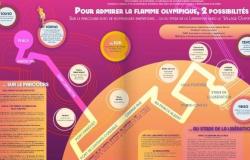Short information videos, practical information: in recent years, users of metropolitan public transport have become accustomed to seeing different types of messages appear on digital panels. The Ligne d’azur advertising agency has renewed the contract that binds it to Cityz Media (formerly Clear Channel), the company which manages, among other things, the thirty digital screens of the four underground tram stations.
Its president, Didier Quillot, former chairman of the board of Lagardère Active and former head of the Professional Football League, details the management of these media which are part of everyday life and defends their use.
What’s new coming soon?
The system will be extended with twelve additional locations, at the Jean-Médecin station and in the park and ride areas.
How and by whom is the content broadcast on these screens managed?
50% by the agency and 50% by Cityz Media. The former can broadcast the messages it wishes, including those from its beneficiaries, in particular from the Metropolis. For the rest, we choose the content, always in compliance with ethical rules. For example, we refuse any message of a political, religious nature or that offends morality.
What is the difference with traditional advertising?
First of all, we do not consider ourselves as an advertising medium but rather as a street media. Digital is not a replica of a poster. We have established partnerships with Brut or Beaux-arts & Cie in order to offer interesting and informative content. We are not in competition with classic print displays but rather in complementarity.
What is the advantage of digital?
Undoubtedly, this allows creativity to be generated. The development potential is immense. It allows several messages to be broadcast during the day, but above all it is a tool at the service of public authorities. For example, in Nice, everything is calibrated in order to be able to broadcast information at short notice in the event of a weather alert or any other risk.
How much does this cost the taxpayer?
Nothing, on the contrary: the contract provides that Ligne d’azur has 50% of the broadcast time. We provide the Metropolis with free shelters which are financed by advertising. And we donate a portion of the advertising revenue to the advertising agency. So it costs nothing but it pays off.
What about the light pollution generated by these screens?
First you should know that the intensity varies depending on the ambient light, so it is restricted in the evening. Then, the regulations would allow us to display for the entire duration of the tram service, approximately from 4:30 a.m. to 1:30 a.m., but we have decided to interrupt them from midnight to 6 a.m. Furthermore, we aim to halve our carbon footprint by 2030, for example by changing the design of street furniture and replacing our vehicle fleet. The public doesn’t necessarily know it, but digital signage has the lowest carbon footprint.
A French company
Cityz Media is a very old company. In 1921, the company Dauphin OTA (Office technique d’affiche) was founded, specializing in painted advertising walls and large-format panels. It joined Clear Channel Communications in 1999, an American company. Then it was sold and became 100% French again in 2023, bought by Equinox Industries, a French private equity company. It was then renamed Cityz Media.
Its regional development director, Stéphane Gaffori, indicates that the company is “present in the South: Aix-en-Provence, Nîmes, Avignon, Monaco… A study was carried out on the impact of digital, it appears that the narrative is more powerful than in print, hence its success. »






